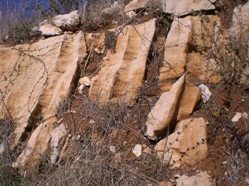
TERROIR
Factors linked to geology that influence wine quality are water availability, nourishment and topography. The much-abused term ‘terroir’ approximates to the sum of these factors, together with aspect and climate.
Picture: Solution hollows in karstic Cenomanian-Turonian limestone at Bargylus vineyard, Syria.
Lebanon is divided into three main geological and topographic units: the Mount Lebanon range, which rises from the sea to 3083m, the Bekaa Valley, which despite the name lies at 800-1200m, and in the east, the Anti Lebanon range, with its highest peak at 2814m. The country’s geological structure consists of two large NNE-SSW trending anticlines (the two mountain ranges) separated by a large syncline (the Bekaa). The Yammouneh Fault, the northern continuation of the Dead Sea transform fault, is responsible for dramatic slopes on the western margin of the Bekaa Valley.
Most of Lebanon comprises lower to middle Cretaceous sandstones and limestones, though early Jurassic limestones occur in the cores of the anticlines, and the southern up-thrust of the Yammouneh Fault. In the Early Tertiary, folding uplifted the Mesozoic rocks as Arabian and African plates collided. The sea retreated from the Bekaa depression, and Miocene-Pliocene conglomerates and lacustrine limestones were deposited. In the Pleistocene, the Bekaa was sporadically submerged beneath a large lake. In the last 10,000 years as the climate has warmed up, the lake has receded leaving rich fertile soils that have been farmed since the dawn of agriculture.
The limestones of the Mount Lebanon range extend north into western Syria and south into Israel and western Jordan. Extensive basaltic plateaux (of probable Miocene age) spread across much of central Syria, and to the south into Jordan.